The Influence of Location along the Pseudostem on Enset Fiber Physio-Mechanical Properties: Application of Weibull Distribution Statistics
Abstract
:1. Introduction
2. Materials and Methods
2.1. Materials
2.2. Sample Preparation of Enset Fiber Portions along the Length
2.3. Tenacity/Tensile Strength Determination
2.4. Determination of Enset Fiber Diameter
2.5. Determination of Bundle Fiber Fineness
2.6. Color of the Fiber
2.7. Work of Rupture
2.8. Statistical Analysis
3. Result and Discussion
3.1. Effect of Location of Enset Bundle Fiber Physical Properties
3.2. Effect of Enset Fiber Section on Mechanical Properties
3.3. Work of Rupture
3.4. Color Value
3.5. Analysis of the Tensile Test Data using Weibull Distribution
4. Conclusions
Author Contributions
Funding
Institutional Review Board Statement
Informed Consent Statement
Data Availability Statement
Acknowledgments
Conflicts of Interest
References
- Sair, S.; Mandili, B.; Taqi, M.; El Bouari, A. Development of a new eco-friendly composite material based on gypsum reinforced with a mixture of cork fibre and cardboard waste for building thermal insulation. J. Reinf. Plast. Compos. 2019, 16, 20–24. [Google Scholar] [CrossRef]
- Aziz, T.; Fan, H.; Khan, F.U.; Ullah, R.; Haq, F.; Iqbal, M.; Ullah, A. Synthesis of carboxymethyl starch-bio-based epoxy resin and their impact on mechanical properties. Z. Phys. Chem. 2020, 234, 1759–1769. [Google Scholar] [CrossRef]
- Bledzki, A.K.; Mamun, A.A.; Faruk, O. Abaca fibre reinforced PP composites and comparison with jute and flax fibre PP composites. Express Polym. Lett. 2007, 1, 755–762. [Google Scholar] [CrossRef]
- Aliotta, L.; Gigante, V.; Coltelli, M.-B.; Cinelli, P.; Lazzeri, A.; Seggiani, M. Thermo-Mechanical Properties of PLA/Short Flax Fiber Biocomposites. Appl. Sci. 2019, 9, 3797. [Google Scholar] [CrossRef] [Green Version]
- Liu, K.; Takagi, H.; Yang, Z. Dependence of tensile properties of abaca fiber fragments and its unidirectional composites on the fragment height in the fiber stem. Compos. Part A Appl. Sci. Manuf. 2013, 45, 14–22. [Google Scholar] [CrossRef]
- Valášek, P.; Müller, M.; Šleger, V.; Kolář, V.; Hromasová, M.; D’Amato, R.; Ruggiero, A. Influence of Alkali Treatment on the Microstructure and Mechanical Properties of Coir and Abaca Fibers. Materials 2021, 14, 2636. [Google Scholar] [CrossRef] [PubMed]
- Godara, S. Effect of chemical modification of fiber surface on natural fiber composites: A review. Mater. Today Proc. 2019, 18, 3428–3434. [Google Scholar]
- Binoj, J.S.; Raj, R.E.; Sreenivasan, V.S.; Thusnavis, G.R. Morphological, physical, mechanical, chemical and thermal characterization of sustainable Indian Areca fruit husk fibers (Areca Catechu L.) as potential alternate for hazardous synthetic fibers. J. Bionic Eng. 2016, 13, 156–165. [Google Scholar] [CrossRef]
- Baley, C.; Gomina, M.; Breard, J.; Bourmaud, A.; Davies, P. Variability of mechanical properties of flax fibres for composite reinforcement. A review. Ind. Crops Prod. 2020, 145, 111984. [Google Scholar] [CrossRef]
- Zewdie, A. Assessment of performance and adoption of improved enset processing technologies Asfaw. IOSR J. Humanit. Soc. Sci. 2020, 25, 1–20. [Google Scholar]
- Ayele, A.; Sahu, O. Extension of Enset Plant Product for Rural Development in Ethiopia. J. Agric. Econ. 2014, 2, 031–040. [Google Scholar]
- Yemataw, Z.; Tesfaye, K.; Grant, M.; Studholme, D.J.; Chala, A. Multivariate analysis of morphological variation in enset (Ensete ventricosum (Welw.) Cheesman) reveals regional and clinal variation in germplasm from south and south western Ethiopia. Aust. J. Crop Sci. 2018, 12, 1135. [Google Scholar] [CrossRef]
- Yemataw, Z.; Tesfaye, K.; Zeberga, A.; Blomme, G. Exploiting indigenous knowledge of subsistence farmers’ for the management and conservation of Enset (Ensete ventricosum (Welw.) Cheesman)(musaceae family) diversity on-farm. J. Ethnobiol. Ethnomed. 2016, 12, 34. [Google Scholar] [CrossRef] [Green Version]
- Sia, C.V.; Nakai, Y.; Shiozawa, D.; Ohtani, H. Statistical analysis of the tensile strength of treated oil palm fiber by utilisation of Weibull distribution model. Open J. Compos. Mater. 2014, 4, 72–77. [Google Scholar] [CrossRef] [Green Version]
- Adugna, D. Manufacturing and Investigation on Mechanical Properties of False Banana Fiber and Glass Fiber Composite Material for Vehicles Body Panel. Ph.D. Thesis, Assam Science and Technology University (ASTU), Assam, India, 2018. [Google Scholar]
- Sinon, F.G.; Kohler, R.; Cotter, M.; Müller, J. Tenacity, fineness and ultimate fiber recovery of abaca fiber strands. J. Biobased Mater. Bioenergy 2011, 5, 433–441. [Google Scholar] [CrossRef]
- Vardhini, K.J.V.; Murugan, R. Effect of laccase and xylanase enzyme treatment on chemical and mechanical properties of banana fiber. J. Nat. Fibers 2017, 14, 217–227. [Google Scholar] [CrossRef]
- Richter, S.; Stromann, K.; Müssig, J. Abacá (Musa textilis) grades and their properties—A study of reproducible fibre characterization and a critical evaluation of existing grading systems. Ind. Crops Prod. 2013, 42, 601–612. [Google Scholar] [CrossRef]
- d’Almeida, J.R.M.; d’Almeida, A.L.F.S.; Calado, V. Evaluation of surface treatment effects on the tensile strength of piassava (Attalea funifera) fibers using the Weibull distribution. Polym. Renew. Resour. 2010, 1, 91–104. [Google Scholar] [CrossRef]
- Thomason, J. On the application of Weibull analysis to experimentally determined single fibre strength distributions. Compos. Sci. Technol. 2013, 77, 74–80. [Google Scholar] [CrossRef]
- Zafeiropoulos, N.; Baillie, C. A study of the effect of surface treatments on the tensile strength of flax fibres: Part II. Application of Weibull statistics. Compos. Part A Appl. Sci. Manuf. 2007, 38, 629–638. [Google Scholar] [CrossRef]
- Mukhopadhyay, S.; Fangueiro, R.; Shivankar, V. Variability of Tensile Properties of Fibers from Pseudostem of Banana Plant. Text. Res. J. 2009, 79, 387–393. [Google Scholar] [CrossRef]
- Lefeuvre, A.; Bourmaud, A.; Baley, C. Optimization of the mechanical performance of UD flax/epoxy composites by selection of fibres along the stem. Compos. Part A Appl. Sci. Manuf. 2015, 77, 204–208. [Google Scholar] [CrossRef]
- Negawo, T.A.; Polat, Y.; Buyuknalcaci, F.N.; Kilic, A.; Saba, N.; Jawaid, M. Mechanical, morphological, structural and dynamic mechanical properties of alkali treated Ensete stem fibers reinforced unsaturated polyester composites. Compos. Struct. 2019, 207, 589–597. [Google Scholar] [CrossRef]
- Charlet, K.; Jernot, J.; Gomina, M.; Bréard, J.; Morvan, C.; Baley, C. Influence of an Agatha flax fibre location in a stem on its mechanical, chemical and morphological properties. Compos. Sci. Technol. 2009, 69, 1399–1403. [Google Scholar] [CrossRef]
- Munawar, S.S.; Umemura, K.; Kawai, S. Characterization of the morphological, physical, and mechanical properties of seven nonwood plant fiber bundles. J. Wood Sci. 2007, 53, 108–113. [Google Scholar] [CrossRef]
- Charlet, K.; Baley, C.; Morvan, C.; Jernot, J.P.; Gomina, M.; Bréard, J. Characteristics of Hermès flax fibres as a function of their location in the stem and properties of the derived unidirectional composites. Compos. Part A Appl. Sci. Manuf. 2007, 38, 1912–1921. [Google Scholar] [CrossRef]
- Virk, A.S. Numerical Models for Natural Fibre Composites with Stochastic Properties. Ph.D. Thesis, University of Plymouth, Plymouth, UK, 2010. [Google Scholar]
- Boopathi, L.; Sampath, P.S.; Mylsamy, K. Investigation of physical, chemical and mechanical properties of raw and alkali treated Borassus fruit fiber. Compos. B Eng. 2012, 43, 3044–3052. [Google Scholar] [CrossRef]
- Fiore, V.; Scalici, T.; Valenza, A. Characterization of a new natural fiber from Arundo donax L. as potential reinforcement of polymer composites. Carbohydr. Polym. 2014, 106, 77–83. [Google Scholar] [CrossRef]
- Cai, M.; Takagi, H.; Nakagaito, A.N.; Katoh, M.; Ueki, T.; Waterhouse, G.I.; Li, Y. Influence of alkali treatment on internal microstructure and tensile properties of abaca fibers. Ind. Crops Prod. 2015, 65, 27–35. [Google Scholar] [CrossRef]
- d’Almeida, J.R.M.; Aquino, R.C.M.P.; Monteiro, S.N. Tensile mechanical properties, morphological aspects and chemical characterization of piassava (Attalea funifera) fibers. Compos. B Eng. 2006, 38, 1473–1479. [Google Scholar] [CrossRef]
- Hearle, J.W.; Morton, W.E. Physical Properties of Textile Fibres, 4th ed.; Woodhead Publishing: Cambridge, UK, 2008. [Google Scholar]
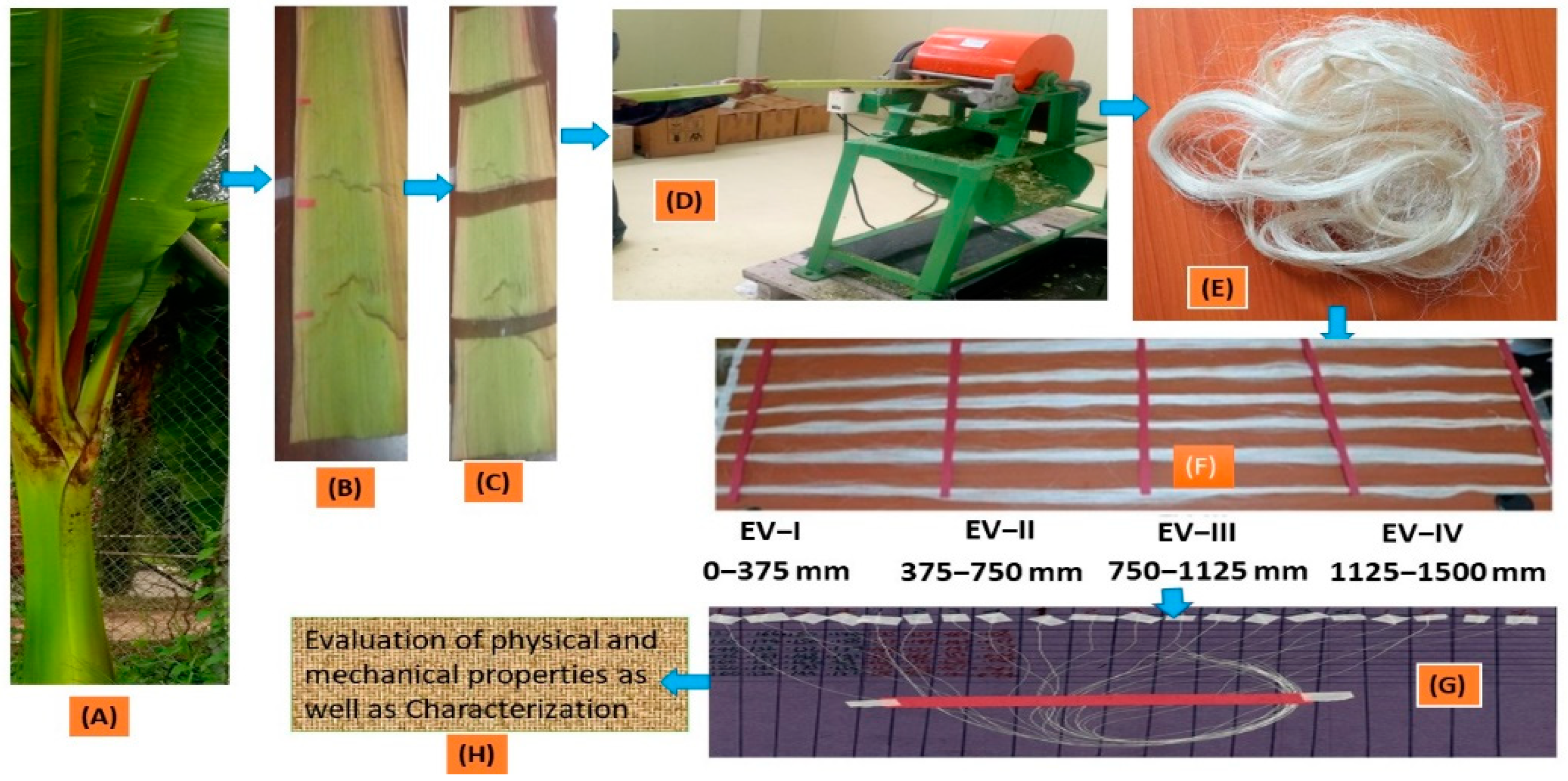


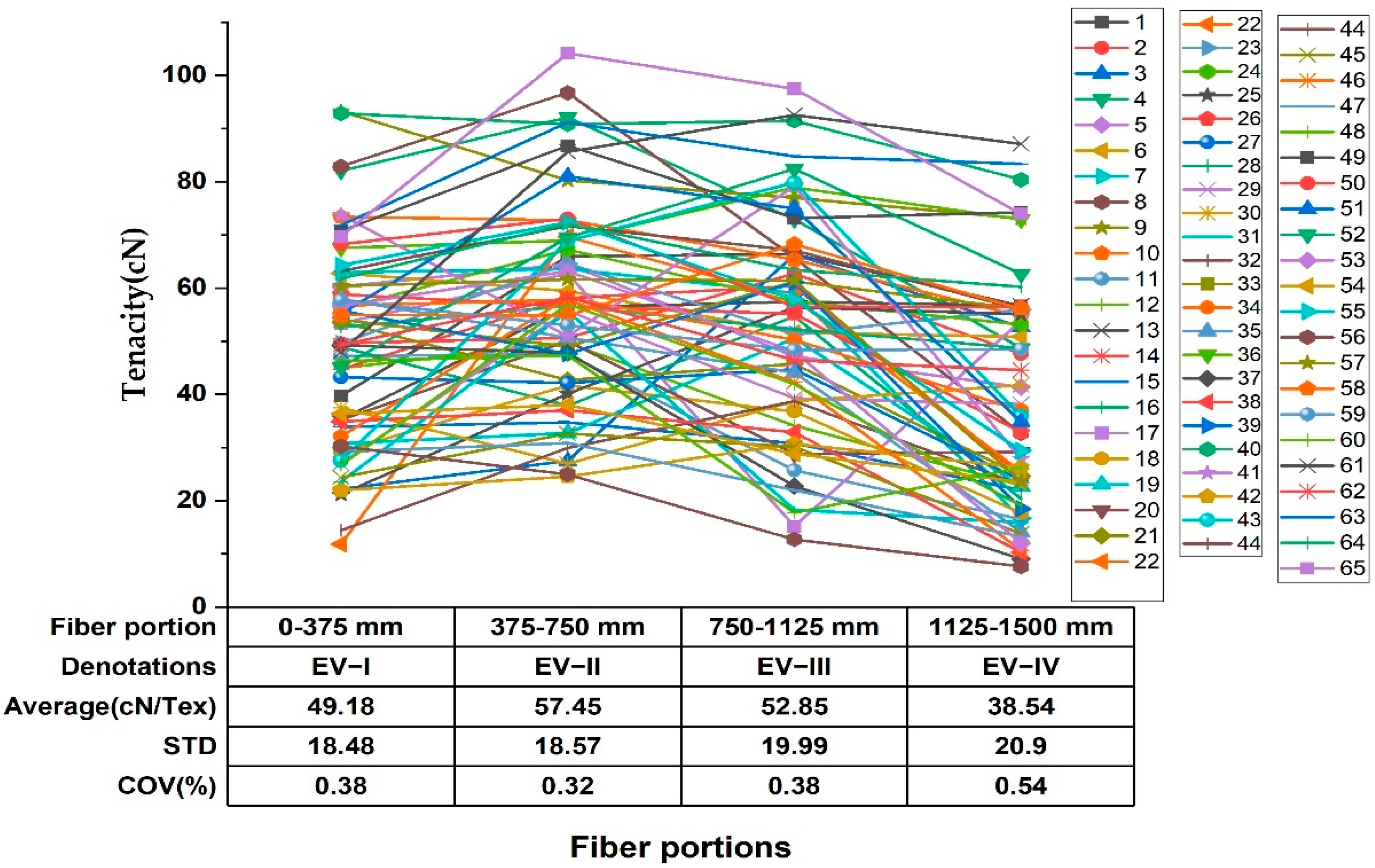
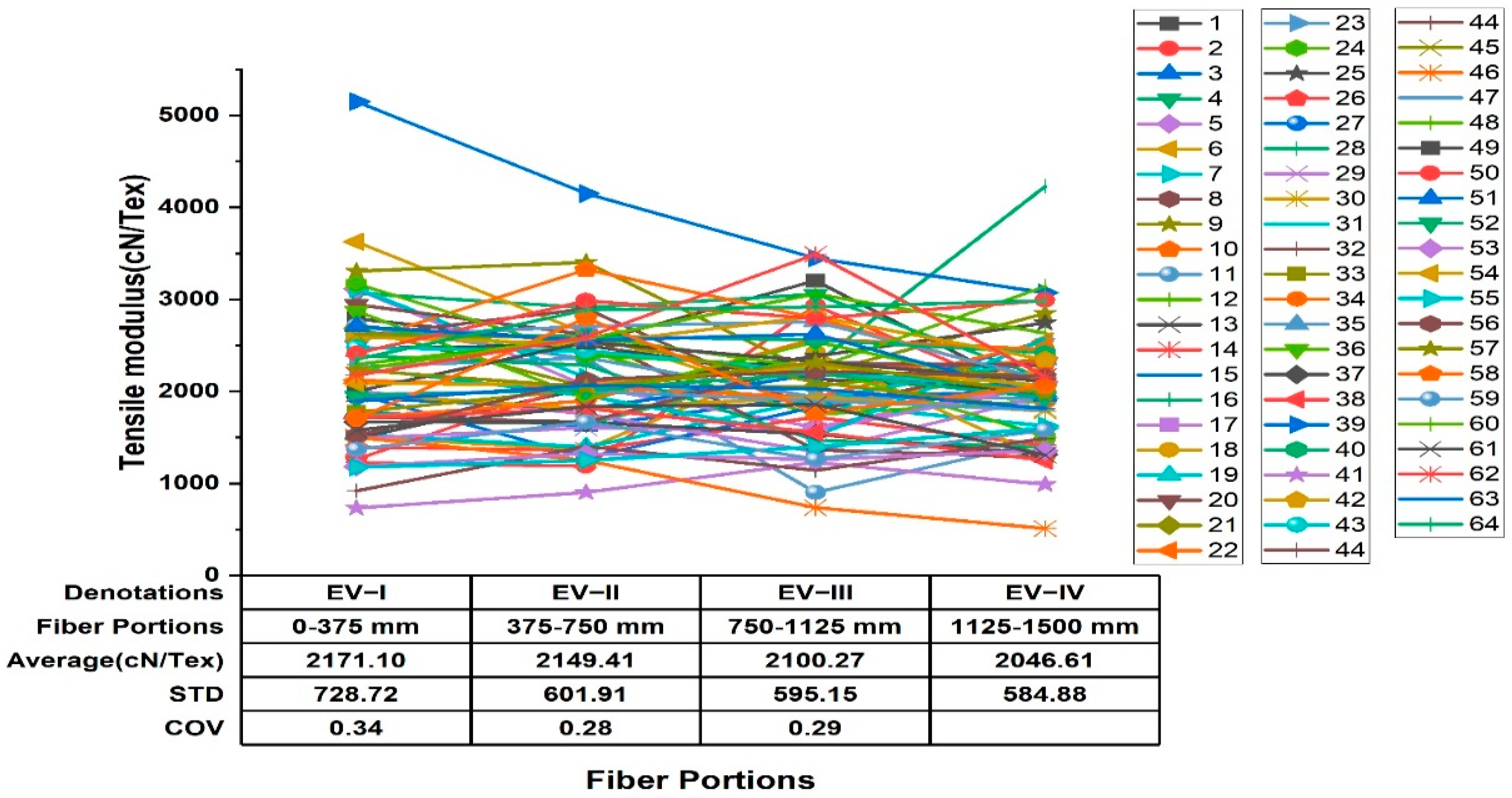
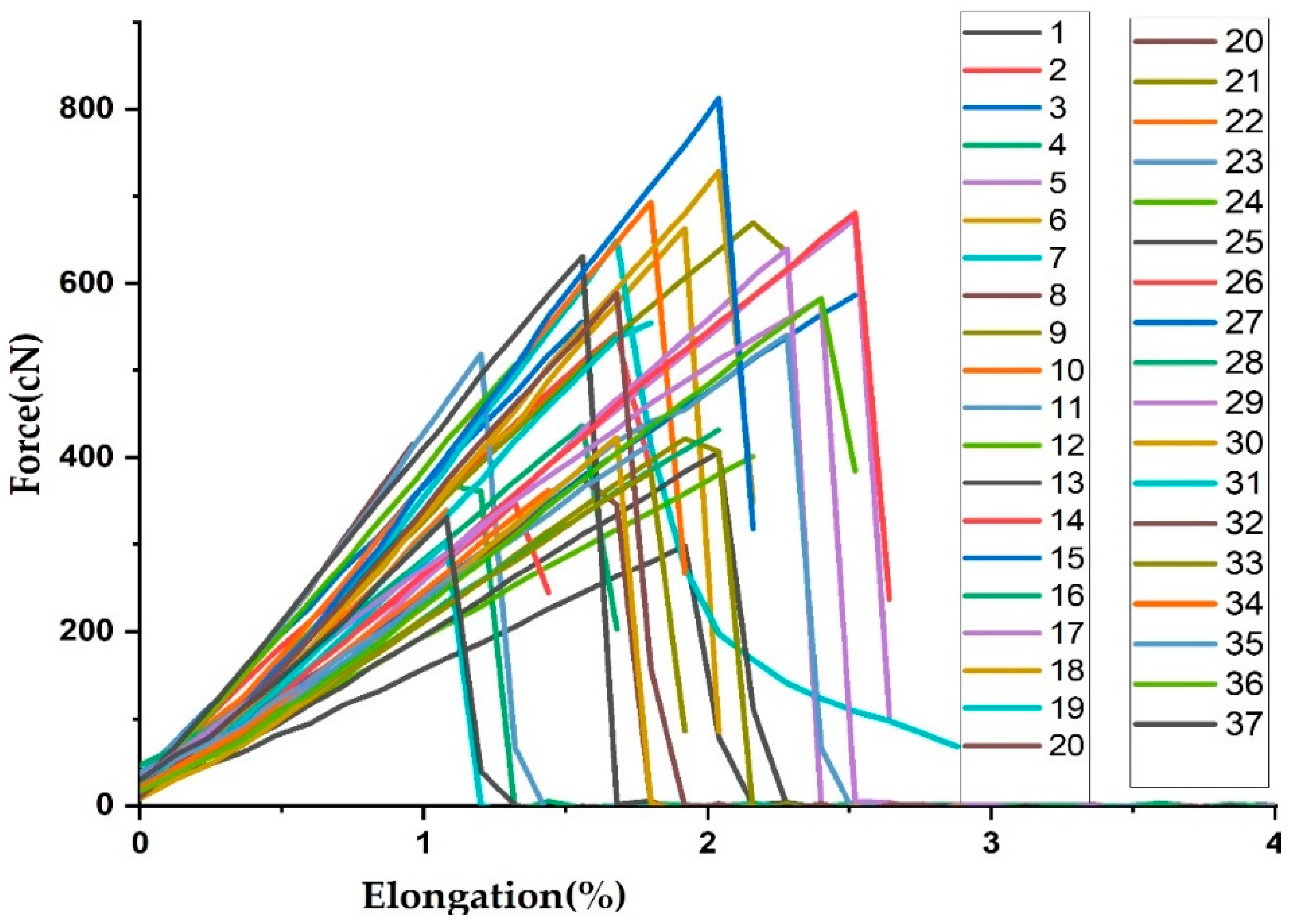
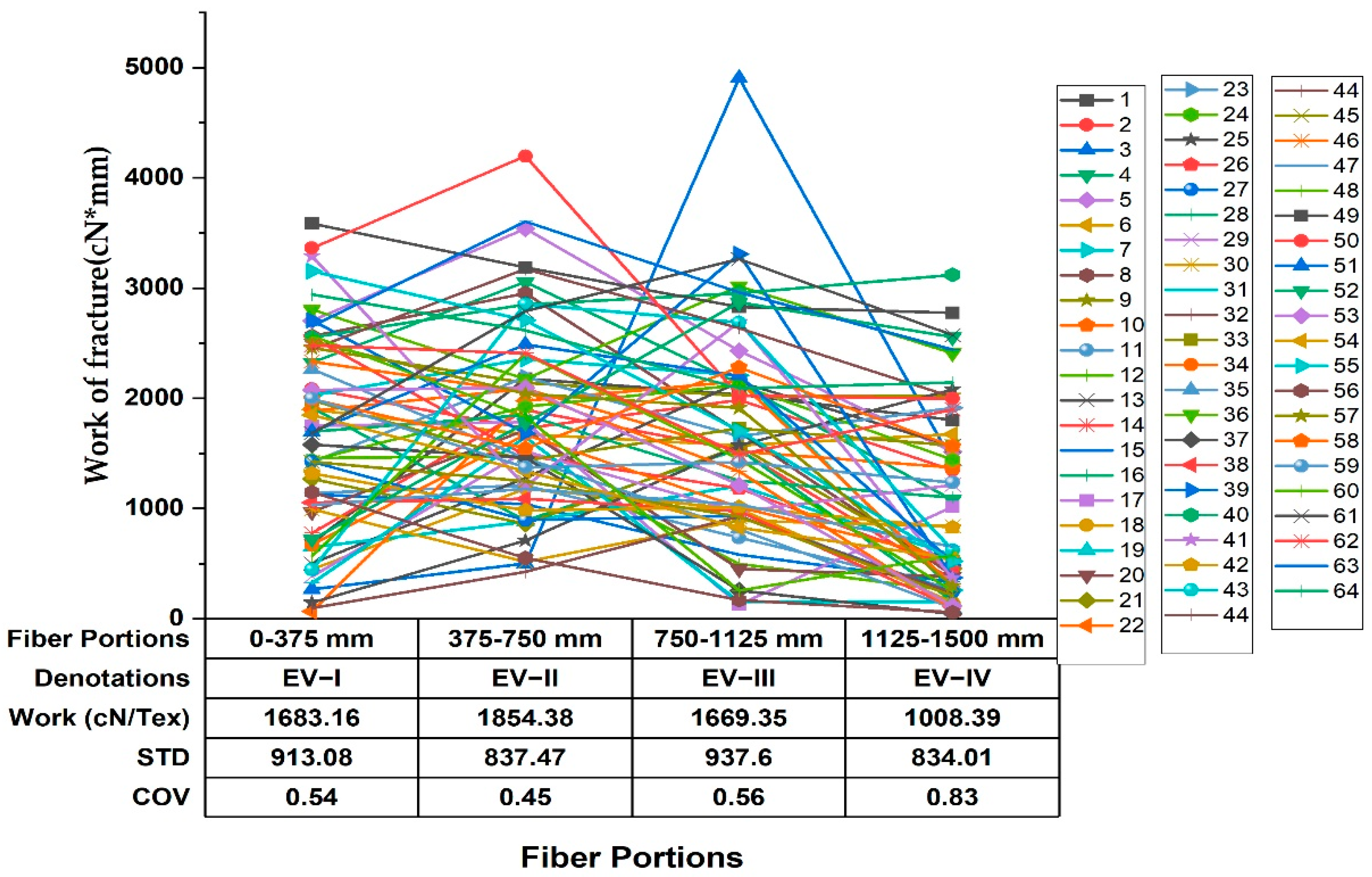


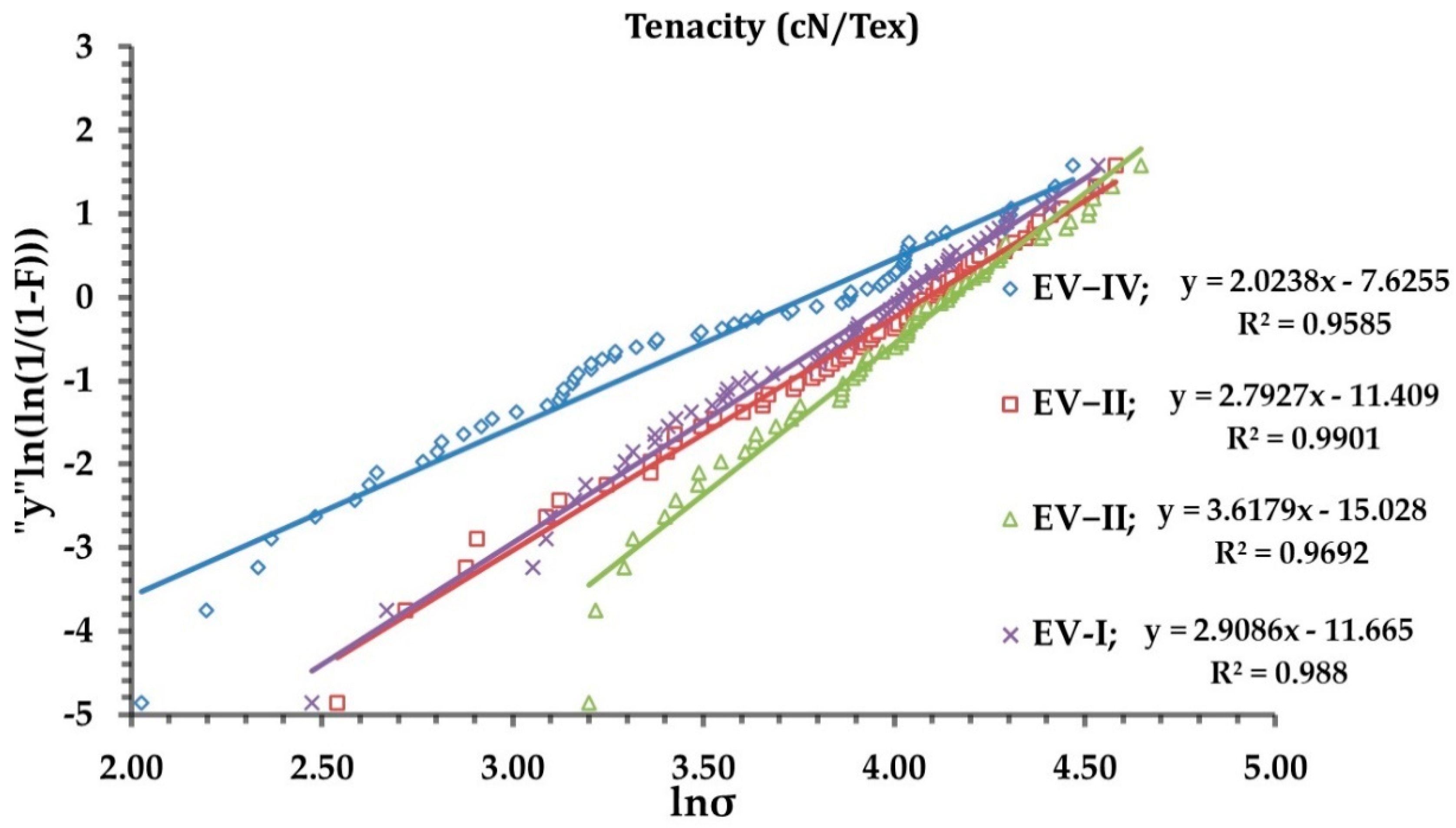
| Fiber Portions | Mass Distribution (mg) | Diameter (µm) | Cros-Sectional Area (mm2) | Linear Density (Tex) |
|---|---|---|---|---|
| EV-I | 5.9 ± 1.98 | 158 ± 31.3 | 0.021 ± 0.008 | 16 ± 5.3 |
| EV-II | 5.4 ± 1.83 | 153 ± 28.4 | 0.019 ± 0.007 | 14 ± 4.9 |
| EV-III | 5.0 ± 1.70 | 140 ± 29.4 | 0.016 ± 0.006 | 13 ± 4.5 |
| EV-IV | 4.8 ± 1.72 | 134 ± 29.4 | 0.015 ± 0.006 | 13 ± 4.6 |
| Fiber Portions | Max. Force (cN) | Tenacity (cN/Tex) | Elongation (%) | Work fracture (cN*mm) | Tensile modulus (cN/Tex) |
|---|---|---|---|---|---|
| EV-I | 661.2 ± 270.2 | 49.2 ± 18.5 | 2.0 ± 0.7 | 1683.2 ± 913.1 | 2105.7 ± 894.6 |
| EV-II | 770.6 ± 274.9 | 57.4 ± 18.6 | 1.9 ± 0.4 | 1854.4 ± 837.5 | 2134.7 ± 608.9 |
| EV-III | 710.1 ± 299.9 | 52.8 ± 20.0 | 1.8 ± 0.6 | 1669.4 ± 937.6 | 2094.4 ± 592.4 |
| EV-IV | 513.7 ± 295.0 | 38.5 ± 20.9 | 1.4 ± 0.6 | 1008.4 ± 834.0 | 2056.0 ± 585.2 |
| Fiber Portions | L* | a* | b* | ΔE |
|---|---|---|---|---|
| EV-I | 81.78 | 0.945 | 8.75 | 4.11 |
| EV-II | 83.28 | 0.72 | 9.475 | 4.52 |
| EV-III | 82.365 | 0.96 | 10.945 | 4.23 |
| EV-IV | 77.945 | 1.24 | 12.21 | 11.68 |
| Parameters | Fiber Locations | |||
|---|---|---|---|---|
| GL at 250 mm | EV-I | EV-II | EV-III | EV-IV |
| σ (CN/Tex) | 49.2 | 57.4 | 52.8 | 38.5 |
| Std | 20.9 | 20 | 10.5 | 18.5 |
| COV | 0.38 | 0.32 | 0.38 | 0.54 |
| (β) | 2.91 | 3.62 | 2.792 | 2.024 |
| (σo)cN/Tex | 55.17 | 63.68 | 59.46 | 43.28 |
| Interactions | Mean Diff | Prob | Sig |
|---|---|---|---|
| EV-II: EV-I | 109.38 | 0.13 | 0 |
| EV-III: EV-I | 48.83 | 0.76 | 0 |
| EV-III: EV-II | −60.55 | 0.62 | 0 |
| EV-IV: EV-I | −147.58 | 0.02 | 1 |
| EV-IV: EV-II | −256.96 | 3.32 × 10−6 | 1 |
| EV-IV: EV-III | −196.41 | 6.42 × 10−4 | 1 |
Publisher’s Note: MDPI stays neutral with regard to jurisdictional claims in published maps and institutional affiliations. |
© 2022 by the authors. Licensee MDPI, Basel, Switzerland. This article is an open access article distributed under the terms and conditions of the Creative Commons Attribution (CC BY) license (https://creativecommons.org/licenses/by/4.0/).
Share and Cite
Dessie, E.; Tesfaye, T.; Gideon, R.K.; Tadesse, M.G.; Qiu, Y. The Influence of Location along the Pseudostem on Enset Fiber Physio-Mechanical Properties: Application of Weibull Distribution Statistics. Appl. Sci. 2022, 12, 7323. https://doi.org/10.3390/app12147323
Dessie E, Tesfaye T, Gideon RK, Tadesse MG, Qiu Y. The Influence of Location along the Pseudostem on Enset Fiber Physio-Mechanical Properties: Application of Weibull Distribution Statistics. Applied Sciences. 2022; 12(14):7323. https://doi.org/10.3390/app12147323
Chicago/Turabian StyleDessie, Esubalew, Tamrat Tesfaye, Rotich Kipchirchir Gideon, Melkie Getnet Tadesse, and Yiping Qiu. 2022. "The Influence of Location along the Pseudostem on Enset Fiber Physio-Mechanical Properties: Application of Weibull Distribution Statistics" Applied Sciences 12, no. 14: 7323. https://doi.org/10.3390/app12147323
APA StyleDessie, E., Tesfaye, T., Gideon, R. K., Tadesse, M. G., & Qiu, Y. (2022). The Influence of Location along the Pseudostem on Enset Fiber Physio-Mechanical Properties: Application of Weibull Distribution Statistics. Applied Sciences, 12(14), 7323. https://doi.org/10.3390/app12147323









